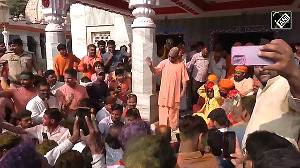

She has been variously hailed as 'a symbol of hope and aspiration', 'a barefoot artist' and 'a collagist of torn hopes.' In the year 2000, she was even honoured with the Sanskriti Award. But Shakila Sheikh, wife of a vegetable vendor from obscure Noorpur (about 64 km from Kolkata, West Bengal), is oblivious of how different she is.
Her daily chores are the same as those of any other woman in her village. What sets her apart from them are her solitary hours of artistic creativity every night. When asked why she has spent the best part of her 30-odd years making pictures that do not assure her material prosperity, she smiles in embarrassment. When asked to explain the secrets of her technical or stylistic particularities, which have earned her considerable fame in recent years, she shyly smiles again.
Shakila's work has been exhibited in art galleries in many cities in India and in Paris, New York, Hanover and Singapore. Yet, despite her growing exposure to contemporary culture both at home and abroad, she has never wavered on her choice of themes. These are drawn directly from life -- baskets of vegetables, domesticated animals, familiar trees, ducks swimming in ponds, walls around mud huts, winding dirt roads or an occasional aeroplane flying across the wide sky. Her social consciousness, too, finds regular aesthetic expression in her treatment of themes like violence against women and communal riots.
 "Each day I create a new image," says Shakila of her Kali series, where she has portrayed the goddess of destruction in all her fearful majesty as the omnipresent protector of her village. In one of her now-famous depictions of the deity, she shows Kali stepping out of her temple and standing on a railway line to stop a speeding train from crushing a helpless cow tethered there.
"Each day I create a new image," says Shakila of her Kali series, where she has portrayed the goddess of destruction in all her fearful majesty as the omnipresent protector of her village. In one of her now-famous depictions of the deity, she shows Kali stepping out of her temple and standing on a railway line to stop a speeding train from crushing a helpless cow tethered there.
Says renowned senior artist, collagist and Shakila's guru B R Panesar, "Shakila's images are original, well-defined and reflect the rural simplicity of her environment. Each work has an underlying meaning and message."
Shakila's transition -- from a daughter of an indigent mother selling vegetables on the sidewalk to a known name in contemporary collage art -- sounds like a fairy tale even though it has only provided her emotional satisfaction. Her transformation has been possible because of her grit, courage and ability to confront the world with love and compassion.
Her success and her designs have provoked much discussion, particularly among contemporary artists with an urban mindset. Perhaps they find it hard to explain why they like the thematically simplistic work of a village artist. The answer seems to lie in the original genius of the medium -- the meticulously torn and arranged shreds of coloured paper -- Shakila has taught herself to use, lending commonplace reality an abstract dimension.
Says Panesar, "She is an artist by instinct." He adds her use of paper is unique in the sense that she tears strips of coloured paper and folds them in a manner as to give them form and volume. Referring to her essentially intuitive, unpremeditated process of creation, Panesar once described her as a 'living collage'.
A former statistician who used to work with street children, Panesar recalls the first time he met Shakila. She struck him as a child with difference even though her clothes were in tatters and she was fighting to forget her hunger. He began supplying her with old newspapers so that she could make paper bags and earn a little money by selling them. Instead, the little girl began making collages with torn newspaper strips. When she showed the result of her effort to Panesar, he took the child under his wing.
To Panesar's deep dismay, the budding young artist was soon married off by her mother. Immediately after marriage, Shakila had three children at fairly close intervals and was increasingly encumbered by household responsibilities.
Within a few years, however, Shakila returned to her hobby. When she showed her newly created collages to Panesar, he decided to seek the opinion of other artists on the quality of her work. Their verdict emboldened him to organise shows of her work. For Shakila, there was no looking back.
She has escaped the wrath of fundamentalists in her own community in Noorpur, thanks to the good sense of the mixed population in this otherwise backward village. She lives with her sharecropper-vendor husband, Akbar, and their three teenage children in a non-too-congenial joint family set-up since they live in close proximity to her husband's other wife and her three children.
But Shakila has learnt to live with such adversities. As long she has her art, she believes she can continue to take life's ups and downs in her stride.
Photos: Women's Feature Service
Image: Lynette Menezes






 © 2025
© 2025